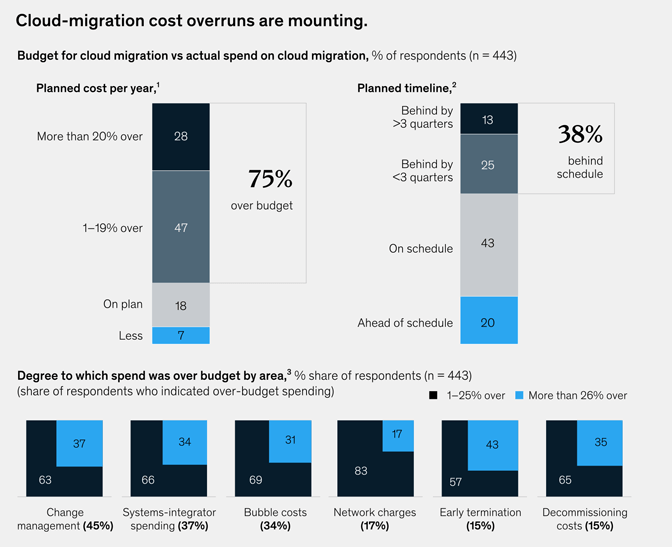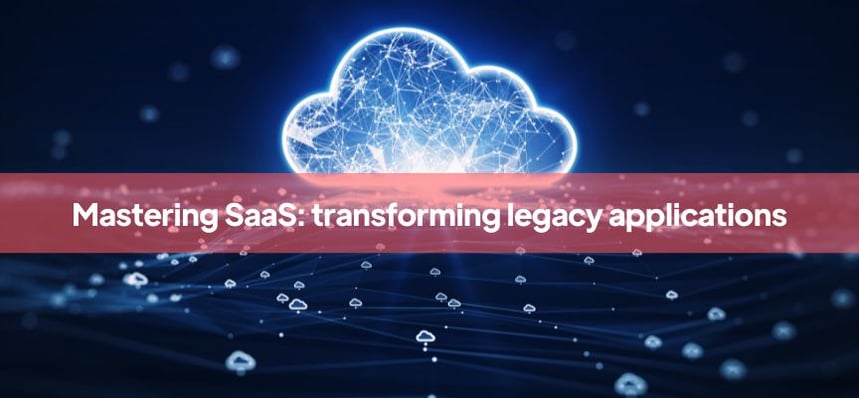By 2024, most businesses aim to allocate 80% of their IT hosting budget to cloud services, encompassing private cloud, IaaS, PaaS, and SaaS to improve the overall efficiency, scalability, and cost-effectiveness. The COVID-19 pandemic has acted as a catalyst for this ambitious target, accelerating the need for digital transformation within enterprises. Yet, the potential to unlock $1 trillion in business value through cloud adoption serves as an even more significant driving force.
Despite this, some organizations are losing out on this value due to inefficiencies in managing cloud migrations, leading to unforeseen costs and delays. McKinsey & Company says that over the next three years, it's projected that around $100 billion will be wasted on migration expenditures.
 Source: McKinsey study
Source: McKinsey study
In fact, migrating legacy applications to the cloud require careful planning, strategy, and execution. This article will outline key strategies for accomplishing this process successfully, drawing insights from the journey of transforming legacy software systems into scalable SaaS solutions as discussed in this previous blog article.
Understanding your legacy applications
Before embarking on a migration journey, it's crucial to understand your legacy applications thoroughly. This includes their architecture, dependencies, data flows, and user interactions. A comprehensive application portfolio analysis will help you identify potential challenges and opportunities for improvement during the migration process.
Choosing the right cloud service provider
Different providers offer different services, pricing models, and levels of support. It's important to choose a provider that aligns with your business needs and has a proven track record of successful migrations.
Planning your migration strategy
There are several strategies for migrating applications to the cloud, including rehosting (lift-and-shift), re-platforming, refactoring, repurchasing, and retiring. The right strategy depends on your specific applications, business needs, and resources. A well-planned migration strategy will minimize downtime, reduce risks, and ensure a smooth transition.
Implementing a hybrid cloud approach
For many businesses, a hybrid cloud approach – combining on-premises, private cloud, and public cloud services – offers the best balance of flexibility, security, and cost-effectiveness. This approach allows you to migrate applications gradually, test performance, and adjust your strategy as needed.
Ensuring security and compliance
Security and compliance are critical considerations when migrating to the cloud. You need to ensure that your cloud provider offers robust security measures, and that your applications and data will be compliant with relevant regulations. A thorough risk assessment and a well-defined security and compliance strategy are essential.
Training your team
Cloud migration is not just a technical challenge, but also a cultural one. Your team needs to be trained on new tools, processes, and mindsets. Investing in training and change management will help ensure a successful migration and foster a cloud-first culture.
Migrating legacy applications to the cloud is a complex but rewarding endeavor. Successfully navigating this journey and reaping the advantages of cloud computing requires a knowledge of your applications, selecting the appropriate cloud service provider, planning your migration strategy, establishing a hybrid cloud approach, ensuring security and compliance, and educating your staff.
Take the next step with Kubeark
With our expertise in migrating legacy applications to SaaS, we can guide you through every step of the process, ensuring a smooth and successful transition. Ready to embark on your SaaS transformation journey? Request a demo today and don't miss this opportunity to transform your legacy applications and embrace the future of SaaS.

